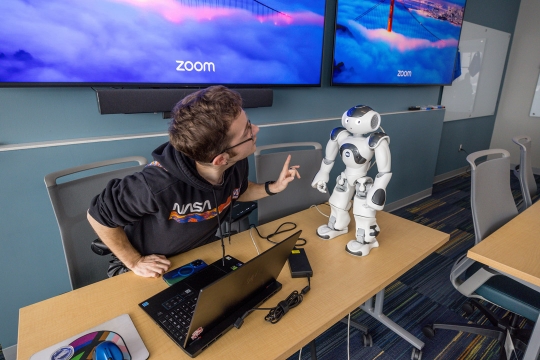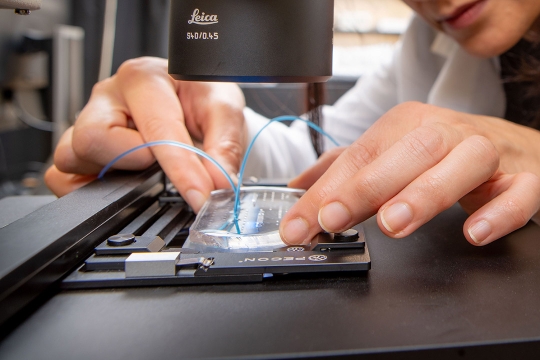
Matt Dye
Professor, SPACE Center
Matt Dye
Professor, SPACE Center
Education
B.Sc. (Hons.), Manchester Polytechnic (United Kingdom); M.Sc., University of Stirling (United Kingdom); Ph.D. University of Southampton (United Kingdom)
Bio
Appointments
Dr. Matt Dye is director of the joint Ph.D. program in Cognitive Science at RIT, director of the NTID SPACE research center, and a professor in the Department of Liberal Studies at RIT/NTID. He also has an extended appointment with the Department of Psychology at RIT and an adjunct appointment with the Department of Neuroscience at URMC.
Education
Moving to the United States from the UK, Dye completed a postdoctoral fellowship in Brain and Cognitive Sciences at the University of Rochester (2002-2009). His Ph.D. in Psychology was awarded in 2001 by the University of Southampton, where he conducted psycholinguistic research on British Sign Language.
Research
Since moving to the U.S., Dye’s work has focused on whether being born deaf means that you see better. His lab conducts research on brain reorganization in the face of altered sensory input, asking what happens to the brain areas and neural pathways associated with visual and multi-sensory processing when auditory input is missing. Most of his research looks at selective visual attention in deaf individuals, asking whether their greater reliance upon visual information in their environment means that their perceptual and cognitive systems are better able to select and process visual information. Dye is also interested in the relationship between vision and language, with a recent project asking how using a sign language alters visual attention and in what ways sign language structure is shaped by properties of the human visual system. His research program has been funded by the National Science Foundation and by NIH.
Teaching
Dye sometimes teaches courses in the undergraduate program in Psychology at RIT. He was also director of a summer school hosted by Stockholm University, and is a co-PI and training coordinator for the Rochester Postdoctoral Partnership.
*** Dr. Dye is accepting applications for the Ph.D. in Cognitive Science to start fall 2025. Please email him if you are interested.***
Select Scholarship
Kartheiser, G., Cormier, K., Bell-Souder,, D., Dye, M., & Sharma, A. (2024). Neurocognitive outcomes in young adults with cochlear implants: The role of early language access and crossmodal plasticity. Hearing Research. https://doi.org/10.1016/j.heares.2024.109074
Dye, M.W.G., & Terhune-Cotter, B. (2023). Development of visual sustained selective attention and response inhibition in deaf children. Memory & Cognition. https://doi.org/10.3758/s13421-022-01330-1
Hirshorn, E.A., Dye, M.W.G., Hauser, P., Supalla, T., & Bavelier, D. (2022). Reading in deaf individuals: Examining the role of the visual word form area. In A. Newman, & G. Grossi (Eds), Changing Brains: Essays on Neuroplasticity in Honor of Helen Neville. Routledge.
Caselli, N.K., Occhino, C., Artacho, B., Savakis, A.E. & Dye, M.W.G. (2022). Perceptual optimization of language: Evidence from American Sign Language. Cognition, 224, https://doi.org/10.1016/j.cognition.2022.105040.
Dye, M.W.G. & Terhune-Cotter, B. (2021). Sustained visual attention in deaf children: A deafcentric perspective. In C. Enns, J. Henner, & L. McQuarrie (Eds), Discussing Bilingualism in Deaf Children: Essays in Honor of Robert Hoffmeister (pp. 60-72). Routledge.
Rodger, H., Lao, J., Stoll, C., Pascalis, O., Dye, M., & Caldara, R. (2021). The recognition of facial expressions of emotion in deaf and hearing individuals. Heliyon, 7(5), e07018.
Terhune-Cotter, B., Conway, C.M., & Dye, M.W.G. (2021). Visual sequence repetition learning is not impaired in signing DHH children. Journal of Deaf Studies & Deaf Education, 26(3), 322-335.
Morgan, G., & Dye, M.W.G. (2020). Executive functions and access to language: The importance of inter-subjectivity. In M. Marschark & H. Knoors (Eds), The Oxford Handbook of Deaf Studies in Learning and Cognition (pp. 268-284). New York, NY: Oxford University Press.
Dye, M.W.G. & Thompson, R. (2020). The perception and production of language in the visual modality: Implications for sign language development. In G. Morgan (Ed.), Understanding Deafness, Language and Cognitive Development: Essays in Honour of Bencie Woll (pp. 133-157). John Benjamins Publishing Co.
Stoll, C., Rodger, H., Lao, J., Richoz, A.-R., Pascalis, O., Dye, M., & Caldara, R. (2019). Quantifying facial expression intensity and signal use in deaf signers. Journal of Deaf Studies and Deaf Education, 24(4), 346-355.
Stoll, C. & Dye, M.W.G. (2019). Sign language experience redistributes attentional resources to the inferior visual field. Cognition, 191, 103957.
Currently Teaching
In the News
-
December 3, 2025

Opening of new Research Building will position RIT at the ‘forefront of discovery’
RIT’s new Research Building officially opened its doors Dec. 2, and inside, faculty and students are gearing up to usher in a new era of discovery on campus.
-
August 20, 2024

New Ph.D. programs welcome students this fall
The university’s two newest Ph.D. programs in cognitive science and physics offer diverse research opportunities for students and help them gain the skills and abilities needed to analyze data and grasp complex concepts. The new programs bring RIT’s total doctoral programs to 15.